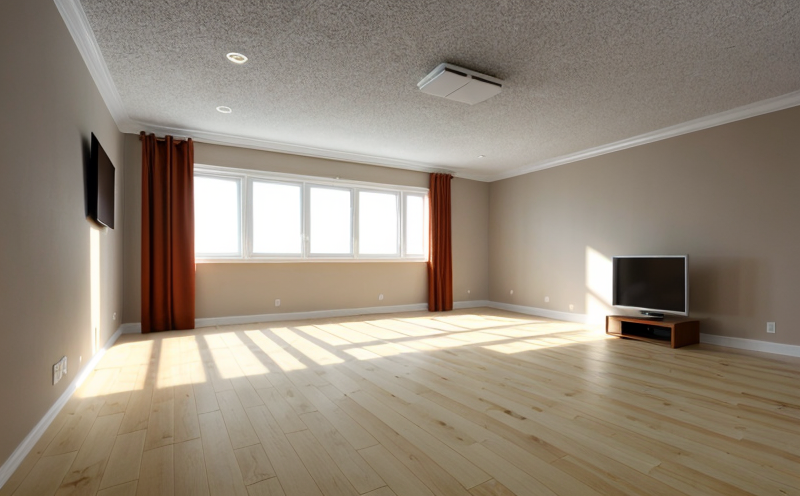Building & Room Acoustics Testing
The field of building and room acoustics testing is crucial in ensuring that spaces meet noise control standards and provide a comfortable acoustic environment. This involves the evaluation of sound insulation, reverberation time, sound absorption coefficients, and other parameters within rooms and buildings.
Building and room acoustics testing can be broadly categorized into two main aspects: airborne sound and impact sound. Airborne sound focuses on isolating external noise from entering a building or room, while impact sound deals with minimizing the transmission of footfall sounds within a structure. This comprehensive approach ensures that both the interior and exterior acoustic environments are optimized for comfort and compliance.
The primary goal is to ensure that buildings meet the specified performance criteria outlined in international standards such as ISO 140-4, which covers general principles and terminology for acoustics in buildings, and ASTM E1267, which provides guidance on the measurement of airborne sound insulation. These standards provide a framework for testing procedures and acceptance criteria.
For quality managers and compliance officers, ensuring that buildings meet these standards is paramount. Acoustic performance can significantly impact occupant well-being and productivity. For R&D engineers, this means exploring innovative materials and designs to enhance acoustic properties. Procurement teams must ensure that the selected building materials comply with acoustics testing requirements.
Accurate and reliable testing methods are essential for achieving compliance and ensuring high-quality results. This involves precise measurement techniques using advanced equipment such as sound level meters, sound intensity probes, and octave band filters. The testing process typically includes setting up controlled environments to simulate real-world conditions under which the acoustic performance of a building or room will be tested.
Room acoustics are particularly important in spaces where speech clarity is critical, such as classrooms, theaters, and conference halls. In these settings, sound diffusion plays a crucial role in ensuring that every listener can hear clearly without any echo or distortion. This involves testing the distribution of sound within the room to ensure even coverage.
For impact acoustics, testing focuses on minimizing noise from foot traffic, which is especially important in residential buildings and office spaces where quiet environments are desired. This requires precise measurement of impact sounds using specialized equipment that can capture low-frequency vibrations effectively.
The results of these tests provide valuable data for quality managers to make informed decisions regarding the design and construction of buildings. Compliance officers use this information to ensure regulatory requirements are met, while R&D engineers apply it to develop new materials or techniques to improve acoustic performance. Procurement teams can leverage this knowledge to select appropriate materials that meet specified acoustic standards.
Understanding the importance of building and room acoustics testing is crucial for anyone involved in the construction industry. By adhering to international standards, quality managers, compliance officers, R&D engineers, and procurement professionals can collaborate effectively to create spaces that not only comply with regulations but also provide a comfortable acoustic environment.
Applied Standards
The field of building and room acoustics testing is governed by several international standards designed to ensure consistent and reliable measurement methods. These include:
- ISO 140-4:2019 – Acoustics — General principles and terminology for buildings
- ASTM E1267-18 – Guide for the measurement of airborne sound insulation in buildings
- EN ISO 12354:2009 – Acoustics — Measurement techniques to determine room acoustic properties
- ASTM E2611-18 – Guide for the measurement of impact sound insulation in buildings
These standards provide a framework for testing procedures and acceptance criteria, ensuring that all tests are conducted using consistent methodologies. Compliance with these standards is essential to ensure accurate results and meet regulatory requirements.
Industry Applications
- Residential Buildings: Ensuring quiet living environments by minimizing noise from external sources and foot traffic.
- Commercial Spaces: Enhancing speech clarity in conference rooms, auditoriums, and lecture halls to improve communication.
- Hospitals and Healthcare Facilities: Reducing noise pollution to provide a calm environment for patients and staff.
- Schools and Universities: Creating conducive learning environments by optimizing sound distribution within classrooms and laboratories.
The application of building and room acoustics testing is not limited to these sectors. It extends to various other industries where acoustic performance plays a vital role in the overall user experience.
Use Cases and Application Examples
In residential buildings, the focus is on sound insulation between apartments to ensure privacy and peace of mind for occupants. For commercial spaces, the emphasis shifts towards enhancing speech clarity and reducing background noise interference. In hospitals and healthcare facilities, minimizing noise pollution is critical for maintaining a calm environment.
For schools and universities, optimizing room acoustics ensures that students can hear clearly during lectures and discussions. This not only enhances learning but also promotes better engagement with the material.
In theaters and concert halls, sound diffusion plays a crucial role in ensuring an immersive audio experience for audience members. The goal is to distribute sound evenly throughout the venue so that every listener has an optimal listening position.
For offices and open-plan workspaces, reducing noise from foot traffic can significantly improve employee productivity by creating quieter working environments. This is particularly important in modern office designs where collaboration and focus are key components of a successful workspace.





